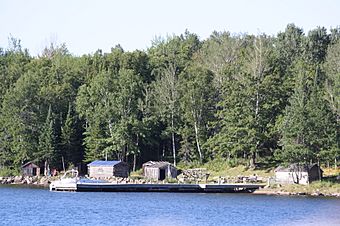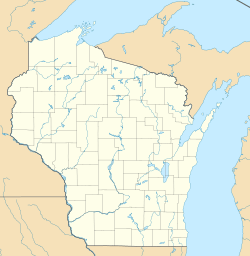Manitou Camp facts for kids
Quick facts for kids |
|
|
Manitou Camp
|
|
 |
|
| Location | Manitou Island, Apostle Islands National Lakeshore, Wisconsin |
|---|---|
| Area | 2.9 acres (1.2 ha) |
| Built | 1890 |
| Architect | Multiple; Olson, Hjalmer |
| Architectural style | Scandinavian Log Cabin |
| NRHP reference No. | 83003367 |
| Added to NRHP | January 19, 1983 |
Manitou Camp is a historic place on Manitou Island in Wisconsin. It's part of the beautiful Apostle Islands National Lakeshore. This camp started way back in the 1890s. It was first used for logging and fishing. Even today, people still use Manitou Camp as a campground and for fishing. It has been recognized as a special historical site since 1983. The National Park Service now takes care of it.
Contents
The First Builders
In the 1890s, four men from Sweden came to Manitou Island. They were there to cut down cedar trees. These men built a special cabin in a style from northern Europe. This cabin is still standing at the camp today!
How the Cabin Was Built
The cabin was made from cedar logs. The builders flattened two sides of each log by hand. They joined the logs using a special method called "half-dove-tailed notches." They filled the gaps between the logs with moss. Inside the cabin, there was a small cellar. You could get to it through a trapdoor in the floor.
After the logging work was finished, three of the Swedish men left. But one man, John Hanson, decided to stay.
Life on the Island
John Hanson lived on this remote island all year round. He spent his time fishing, smoking meat, and growing food in a garden. He even had a horse! John Hanson built a shed for storing fishing twine. This shed is also still at the camp.
Later, a man from France named Gus Plud joined him. In the 1920s or 1930s, another fisherman named Frank Childs built a cabin there. He fished in the winter with a man known as Black Pete. Around the early 1930s, John Hanson built a smokehouse. He used it to smoke herring fish and venison (deer meat). Later, a person called Captain Bark also fished from the camp during the winter.
Fishing Adventures
One important goal for these fishermen was catching herring. Herring would swim close to the island in large numbers during November and December. The fishermen would clean and salt the herring right at Manitou Camp. Then, they packed the fish into barrels. These barrels were then taken to Bayfield.
Winter Fishing
After the lake froze over, the fishermen used dogsleds. They drove their sleds across the ice. They would hang gill nets on lines and poles under the ice. After a day or two, they would collect their catch. This usually included whitefish and lake trout. You can still see an old wooden fish sled at the camp today.
The Olson Brothers
In the 1930s, two brothers from Norway, Theodore and Hjalmer Olson, started fishing from Manitou Camp in the winters. In 1938, they bought the camp. They decided to live there all year.
New Buildings
The Olsons built a new log bunkhouse. It was about 14 by 18 feet in size. This building was also made in a Scandinavian style and is still there. They also built another twine shed to store their fishing nets. The Olson brothers rented cabins to other loggers and fishermen. They continued to live at Manitou Camp at least into the 1980s.
Camp Remnants
Around the camp, you can find many old items. These include a couple of old outhouses and a handmade windlass. There are also boat skids and the remains of a pier. You can see handmade fish boxes, a net reel, and a net fork. There's also a tarring tank and a gutting board. Salt barrels are still there too.
These old items show what the fishing industry was like. They were left where they were used. This is what makes Manitou Camp special. Most other dock areas were cleaned up or built on. But Manitou Camp still looks much like it did long ago.



